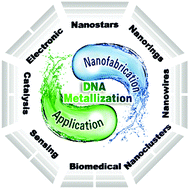当前位置:
X-MOL 学术
›
Chem. Soc. Rev.
›
论文详情
Our official English website, www.x-mol.net, welcomes your feedback! (Note: you will need to create a separate account there.)
DNA metallization: principles, methods, structures, and applications
Chemical Society Reviews ( IF 46.2 ) Pub Date : 2018-04-03 00:00:00 , DOI: 10.1039/c8cs00011e Zhaowei Chen 1, 2, 3, 4, 5 , Chaoqun Liu 1, 2, 3, 4, 5 , Fangfang Cao 1, 2, 3, 4, 5 , Jinsong Ren 1, 2, 3, 4, 5 , Xiaogang Qu 1, 2, 3, 4, 5
Chemical Society Reviews ( IF 46.2 ) Pub Date : 2018-04-03 00:00:00 , DOI: 10.1039/c8cs00011e Zhaowei Chen 1, 2, 3, 4, 5 , Chaoqun Liu 1, 2, 3, 4, 5 , Fangfang Cao 1, 2, 3, 4, 5 , Jinsong Ren 1, 2, 3, 4, 5 , Xiaogang Qu 1, 2, 3, 4, 5
Affiliation

|
DNA metallization has witnessed tremendous growth and development, from the initial simple synthesis aimed at manufacturing conductive metal nanowires to the current fabrication of various nanostructures for applications in areas as diverse as nanolithography, energy conversion and storage, catalysis, sensing, and biomedical engineering. To this, our aim here was to present a comprehensive review to summarize the research activities on DNA metallization that have appeared since the concept was first proposed in 1998. We start with a brief presentation of the basic knowledge of DNA and its unique advantages in the template-directed growth of metal nanomaterials, followed by providing a systematic summary of the various synthetic methods developed to date to deposit metals on DNA scaffolds. Then, the leverage of DNAs with different sequences, conformations, and structures for tuning the synthesis of feature-rich metal nanostructures is discussed. Afterwards, the discussion is divided around the applications of these metal nanomaterials in the fields mentioned above, wherein the key role DNA metallization plays in enabling high performance is emphasized. Finally, the current status and some future prospects and challenges in this field are summarized. As such, this review would be of great interest to promote the further development of DNA metallization by attracting researchers from various communities, including chemistry, biology, physiology, material science, and nanotechnology as well as other disciplines.
中文翻译:

DNA金属化:原理,方法,结构和应用
从最初旨在制造导电金属纳米线的简单合成到目前各种纳米结构的制造,DNA金属化已经见证了巨大的增长和发展,这些纳米结构用于纳米光刻,能量转换和存储,催化,传感和生物医学工程等领域。为此,我们的目的是提出一个全面的综述,总结自1998年首次提出该概念以来出现的有关DNA金属化的研究活动。我们首先简要介绍DNA的基本知识及其在DNA中的独特优势。模板指导的金属纳米材料生长,然后提供迄今为止开发的各种合成方法的系统总结,这些合成方法可将金属沉积在DNA支架上。然后,利用不同序列的DNA的杠杆作用,构型和结构,以调整合成功能丰富的金属纳米结构。此后,围绕这些金属纳米材料在上述领域中的应用进行了讨论,其中着重强调了DNA金属化在实现高性能方面的关键作用。最后,总结了该领域的现状,未来的发展前景和面临的挑战。因此,这项综述将吸引来自化学,生物学,生理学,材料科学,纳米技术以及其他学科等各个领域的研究人员,对促进DNA金属化的进一步发展具有极大的兴趣。这些讨论围绕这些金属纳米材料在上述领域中的应用进行了讨论,其中着重强调了DNA金属化在实现高性能方面的关键作用。最后,总结了该领域的现状,未来的发展前景和面临的挑战。因此,通过吸引来自不同领域的研究人员,包括化学,生物学,生理学,材料科学,纳米技术以及其他学科,来促进DNA金属化的进一步发展,这一综述将引起极大的兴趣。这些讨论围绕这些金属纳米材料在上述领域中的应用进行了讨论,其中着重强调了DNA金属化在实现高性能方面的关键作用。最后,总结了该领域的现状,未来的发展前景和面临的挑战。因此,这项综述将吸引来自化学,生物学,生理学,材料科学,纳米技术以及其他学科等各个领域的研究人员,对促进DNA金属化的进一步发展具有极大的兴趣。
更新日期:2018-04-03
中文翻译:

DNA金属化:原理,方法,结构和应用
从最初旨在制造导电金属纳米线的简单合成到目前各种纳米结构的制造,DNA金属化已经见证了巨大的增长和发展,这些纳米结构用于纳米光刻,能量转换和存储,催化,传感和生物医学工程等领域。为此,我们的目的是提出一个全面的综述,总结自1998年首次提出该概念以来出现的有关DNA金属化的研究活动。我们首先简要介绍DNA的基本知识及其在DNA中的独特优势。模板指导的金属纳米材料生长,然后提供迄今为止开发的各种合成方法的系统总结,这些合成方法可将金属沉积在DNA支架上。然后,利用不同序列的DNA的杠杆作用,构型和结构,以调整合成功能丰富的金属纳米结构。此后,围绕这些金属纳米材料在上述领域中的应用进行了讨论,其中着重强调了DNA金属化在实现高性能方面的关键作用。最后,总结了该领域的现状,未来的发展前景和面临的挑战。因此,这项综述将吸引来自化学,生物学,生理学,材料科学,纳米技术以及其他学科等各个领域的研究人员,对促进DNA金属化的进一步发展具有极大的兴趣。这些讨论围绕这些金属纳米材料在上述领域中的应用进行了讨论,其中着重强调了DNA金属化在实现高性能方面的关键作用。最后,总结了该领域的现状,未来的发展前景和面临的挑战。因此,通过吸引来自不同领域的研究人员,包括化学,生物学,生理学,材料科学,纳米技术以及其他学科,来促进DNA金属化的进一步发展,这一综述将引起极大的兴趣。这些讨论围绕这些金属纳米材料在上述领域中的应用进行了讨论,其中着重强调了DNA金属化在实现高性能方面的关键作用。最后,总结了该领域的现状,未来的发展前景和面临的挑战。因此,这项综述将吸引来自化学,生物学,生理学,材料科学,纳米技术以及其他学科等各个领域的研究人员,对促进DNA金属化的进一步发展具有极大的兴趣。

























 京公网安备 11010802027423号
京公网安备 11010802027423号